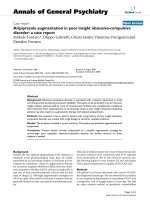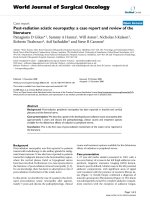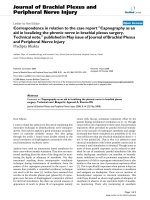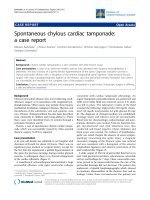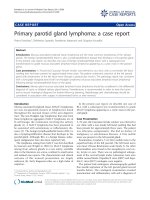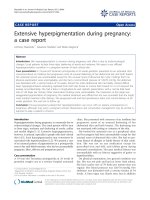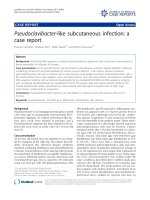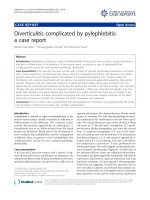Báo cáo y học: "Pregnancy-induced obsessive compulsive disorder: a case report" pps
Bạn đang xem bản rút gọn của tài liệu. Xem và tải ngay bản đầy đủ của tài liệu tại đây (193.52 KB, 3 trang )
BioMed Central
Page 1 of 3
(page number not for citation purposes)
Annals of General Psychiatry
Open Access
Case report
Pregnancy-induced obsessive compulsive disorder: a case report
Harish Kalra
1
, Rajul Tandon
2
, Jitendra kumar Trivedi
3
and
Aleksandar Janca*
1,4
Address:
1
Department of Psychiatry, Royal Perth Hospital, Perth WA 6000, Australia,
2
Grampians Psychiatric Services, Ballarat Health Services,
Ballarat VIC 3350, Australia,
3
Department of Psychiatry, King George Medical University, Lucknow – 226003, U.P., India and
4
University of
Western Australia, School of Psychiatry and Clinical Neurosciences, Perth WA 6000, Australia
Email: Harish Kalra - ; Rajul Tandon - ; Jitendra kumar Trivedi - ;
Aleksandar Janca* -
* Corresponding author
Abstract
Pregnancy is a well-recognised risk factor in precipitating obsessive-compulsive disorder. We
present and discuss a case with the onset of obsessive-compulsive disorder in the fourth month of
gestation, which fully recovered two weeks after delivery. The phenomenology of the observed
disorder was similar to earlier reports of obsessive-compulsive disorder in pregnancy, i.e. the
obsessions and compulsions were predominantly related to the concern of contaminating the
foetus resulting in washing compulsions. Despite the initial success with anti-obsessional drugs, the
patient stopped the medication in the last month of gestation. Nevertheless, she fully recovered
two weeks after the delivery without any psychiatric intervention. There were no obsessive-
compulsive symptoms at one-year follow up. The possible mechanisms involved in the aetiology of
this case, and future research directions in understanding the role of pregnancy in OCD are
discussed.
Introduction
Pregnancy and the postpartum period are known to influ-
ence the onset and course of various psychiatric disorders
such as mood disorders, psychotic disorders, and anxiety
disorders. [1-3] There is considerable evidence that sug-
gests the role of stressful events, including pregnancy and
childbirth, in precipitating or exacerbating obsessive-com-
pulsive disorder (OCD). [4] Various studies have evalu-
ated the role of pregnancy in OCD and have reported
onset and exacerbation of OCD in a significant percentage
of their study groups. [5-7]
Postpartum OCD has been described as having onset
within the first three weeks of delivery. [8,9] Here we
report a patient whose OCD had its onset during preg-
nancy and remitted following delivery. To the best of our
knowledge, this is the first report describing onset of OCD
during pregnancy with spontaneous complete recovery
following delivery.
Case presentation
A 30-year old primigravida woman presented to the out-
patient department in the fourth month of gestation. She
had no past history of psychiatric illness. Her chief com-
plaints were contamination obsessions and washing com-
pulsions in the preceding one month. Preoccupied with
thoughts of contamination, she had started spending the
majority of time washing herself or cleaning various
household items. She described these thoughts as being
her own and recognised them to be "irrational", but she
Published: 15 June 2005
Annals of General Psychiatry 2005, 4:12 doi:10.1186/1744-859X-4-12
Received: 17 May 2005
Accepted: 15 June 2005
This article is available from: />© 2005 Kalra et al; licensee BioMed Central Ltd.
This is an Open Access article distributed under the terms of the Creative Commons Attribution License ( />),
which permits unrestricted use, distribution, and reproduction in any medium, provided the original work is properly cited.
Annals of General Psychiatry 2005, 4:12 />Page 2 of 3
(page number not for citation purposes)
could not resist them. She was distressed and unable to
maintain her employment. Washing compulsions
relieved her anxiety. However, she could not offer an
explanation as to what she feared about contamination.
No depressive or psychotic symptoms were elicited. Bio-
chemical investigations, including metabolic and thyroid
function studies, were in the normal range. She was diag-
nosed with OCD according to ICD-10 criteria [10].
Pharmacotherapy, offered at the first consultation, was
refused by the patient because of her (non-obsessional)
concerns about teratogenic effects of drugs. Behavioural
therapy in the form of thought stopping was begun. The
patient reported exacerbation of symptoms at the next
consultation and subsequently disclosed that her obses-
sional thoughts also concerned the fear of contaminating
her unborn baby. She repeatedly washed to avoid damage
to her foetus. One month after her initial presentation,
fluoxetine was started, at an initial dose of 20 mg/day
gradually and gradually increased to 60 mg/day over the
next four weeks. The patient reported reduction of obses-
sional and compulsive symptoms, and was able to resume
her work. She remained on fluoxetine until the eighth
month of pregnancy with no reports of exacerbation.
However, the patient stopped the medication during the
last month of gestation on the alleged advice of family
members. The patient again experienced the relapse of
intrusive obsessional thoughts followed by compulsions,
but refused to resume pharmacotherapy until delivery.
The patient returned to the outpatient clinic fifteen days
postpartum. The patient described no obsessive thoughts
or washing compulsions for the preceding one week. She
was followed up for five visits in the next one year without
any reports of obsessions or compulsions.
Discussion
There is evidence supporting the role of major life events
including pregnancy and delivery in precipitating OCD.
[4] However, to the best of our knowledge, there are no
specific reports showing complete resolution of OCD after
delivery in cases having onset during pregnancy. In two
studies addressing the role of pregnancy in OCD, Neziro-
glu et al [5] and Williams et al [6] found pregnancy to be
associated with onset of OCD in 39% and 13% patients,
respectively. It occurred in primigravida in 52% of the
patients. [5] Our case too had its onset in her first preg-
nancy at the fourth month of gestation. Our patient had
major symptoms in the form of obsessions of contamina-
tion and compulsions with the underlying fear of contam-
inating her foetus. This phenomenology is in consonance
with the literature. [4,11] Purely intrusive obsessional
thoughts with the same underlying theme have also been
described in a case series of postpartum OCD. [8]
The underlying mechanism can only be speculative at this
stage. As full recovery was seen after delivery, our case
report negates the proposed mechanism in postpartum
OCD of adverse impact on serotonergic functions by
rapid withdrawal of oestrogen and progesterone in post-
partum period [9]. We propose it to be considered as
equivalent to chorea gravidarum, which is also character-
ised by onset of involuntary movements during preg-
nancy with complete resolution after delivery. [12] Basal
ganglia abnormalities are known to occur in pregnancy as
in chorea gravidarum. Similarly, basal ganglia pathology,
especially involving the caudate nucleus, has been impli-
cated in OCD [13-15]. We hypothesize that similar mech-
anisms may underlie both chorea gravidarum and this
case of pregnancy-induced OCD.
An underlying mechanism proposed for chorea gravi-
darum of enhanced dopaminergicsensitivity under the
effect of elevated levels of female sex hormones due to
pregnancy [16] could also be presumed as operating in
this case but involving serotonin instead of dopamine.
Our patient showed significant improvement with fluoxe-
tine before being ceased by the patient, thus indirectly
supporting serotonin dysfunction. Previous reports of
post-partum OCD have also shown good response to
fluoxetine. [9]
Careful prospective studies of pregnancy-associated OCD
will help in understanding predisposing and aetiological
factors involved in such cases. Comparison of chorea
gravidarum and OCD in pregnancy by functional imaging
techniques like PET/SPECT/fMRI might prove useful in
understanding pathophysiological processes responsible
for these disorders.
Competing interests
The author(s) declare that they have no competing inter-
ests.
Acknowledgements
The authors acknowledge the valuable comments made on earlier drafts by
Dr Lindsay Allet.
References
1. Paffenbarger RA: Epidemiological aspects of mental illness
associated with childbearing:. In Motherhood and Mental illness
Edited by: Brockington IF, Kumar R. New York: Grune & Stratton;;
1982:19-36.
2. Kendall RE, Mcguire RJ, Connor Y, et al.: Mood changes in the first
three weeks of after childbirth. J Affect Disord 1981, 3:317-326.
3. O'Hara MW: Postpartum blues, depression, and psychosis: a
review. J Psychosom Obstet Gynecol 1987, 7:205-227.
4. Abramowitz JS, Schwartz SA, Moore KM, Luenzmann KR: Obses-
sive-compulsive symptoms in pregnancy and the puerper-
ium: A review of the literature. J Anxiety Disord 2003, 17:461-478.
5. Neziroglu F, Anemone R, Yaryura-Tobias J: Onset of obsessive-
compulsive disorder in pregnancy. Am J Psychiatry 1992,
149:947-950.
Publish with BioMed Central and every
scientist can read your work free of charge
"BioMed Central will be the most significant development for
disseminating the results of biomedical research in our lifetime."
Sir Paul Nurse, Cancer Research UK
Your research papers will be:
available free of charge to the entire biomedical community
peer reviewed and published immediately upon acceptance
cited in PubMed and archived on PubMed Central
yours — you keep the copyright
Submit your manuscript here:
/>BioMedcentral
Annals of General Psychiatry 2005, 4:12 />Page 3 of 3
(page number not for citation purposes)
6. Williams K, Koran L: Obsessive-compulsive disorder in preg-
nancy, the puerperium, and the premenstrual. J Clin Psychiatry
1997, 58:330-334.
7. Mania G, Albert U, Bogetto F, Vaschetto P, Ravizza L: Recent life
events and obsessive-compulsive disorder: the role of preg-
nancy /delivery. Psychiatry Res 1999, 89:49-58.
8. Sichel DA, Cohen LS, Dimmock JA, Rosenbaum JF: Postpartum
Obsessive-compulsive disorder: a case series. J Clin Psychiatry
1993, 54:156-159.
9. Sichel DA, Cohen LS, Rosenbaum JF, Driscoll JD: Postpartum
onset of obsessive-compulsive disorder. Psychosomatics 1993,
34:277-279.
10. World Health Organisation: The ICD-10 classification of mental
and behavioural disorders: clinical descriptions and diagnos-
tic guidelines. Geneva: WHO 1992.
11. Buttolph ML, Holland AD: Obsessive-compulsive disorder in
pregnancy and childbirth. In Obsessive- compulsive disorder: Theory
and Management Edited by: Jenike M, Baer L, Minichello WE. Chicago:
Yearbook Medical; 1990:89-97.
12. Cordoso F: Chorea gravidarum. Arch Neurol 2002, 59:868-870.
13. Baxter LR, Phelps ME, Mazziota JC, et al.: Local cerebral metabolic
rates in Obsessive-compulsive disorder. Arch Gen Psychiatry
1987, 44:211-218.
14. Luxenberg JS, Swedo S, Flament M, et al.: Neuroanatomic abnor-
malities in Obsessive-compulsive disorder detected with
quantitative X-ray computed tomography. Am J Psychiatry
1988, 145:1089-1093.
15. Swedo SE, Shapiro MB, Grady CL, et al.: Cerebral glucose metab-
olism in childhood onset obsessive-compulsive disorder. Arch
Gen Psychiatry 1989, 46:518-523.
16. Unno S, Iijima M, Osawa M, Uchiyama S, Iwata M: A case of chorea
gravidarum with moyamoya disease. Rinsho Shinkeigaku 2000,
40:78-82.


